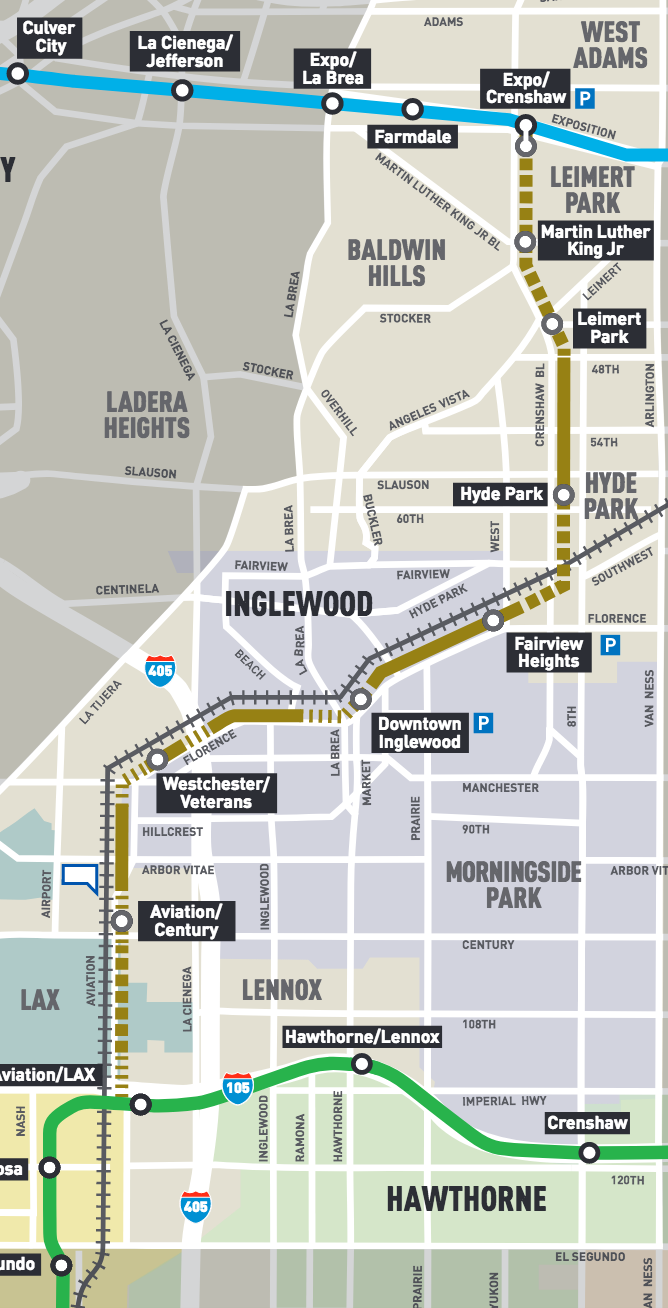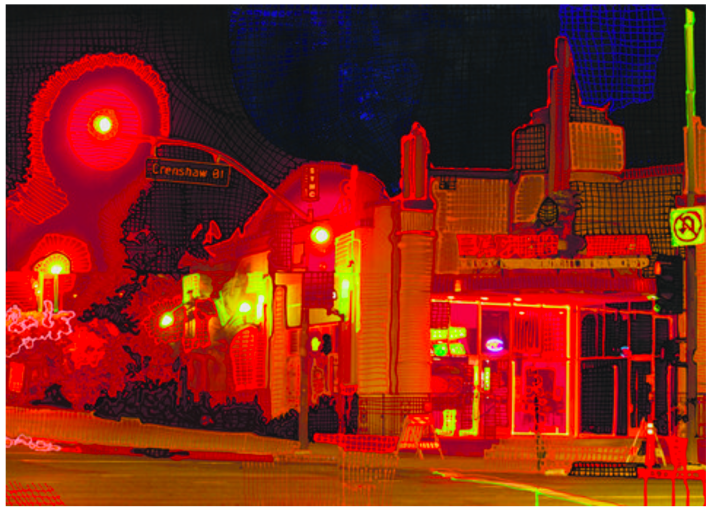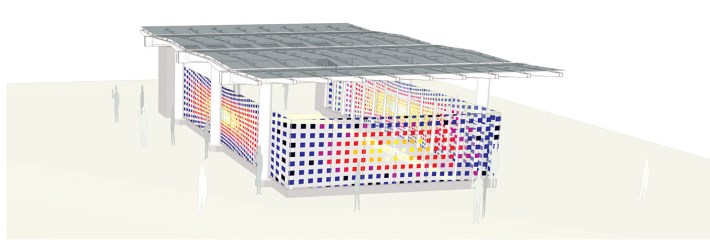Last week, Metro's The Source posted a time-lapse video of the assembly of a massive - and beautiful - mosaic destined for the Expo/Crenshaw station by artist Rebeca Méndez.
Méndez is one of three artists whose work will grace the station and one of fourteen whose work will be featured at stations along the under-construction Crenshaw/LAX Line.
It's one of several such videos Metro has put out to showcase its art program, the artists, and the process the artists are using to tie their work (and the stations) to place along the Crenshaw/LAX Line.
I first took a look at what might be expected of the artists back in 2015, when the finalists were announced. In the intervening years, I've wondered how well the artists would capture the spirit and stories of the community, given that few were from or had deep roots in either the Crenshaw or Inglewood communities.
Inspired by the look at Méndez' work to synthesize the artists' journeys over the last couple of years, I've compiled Metro's videos and the artists' in-progress works here to get a fuller picture of what people can expect to see along the line when it finally opens next year.
If there are any overarching takeaways to be had, they are tied to Metro's interest in having the art speak primarily to and about the people who are passing through a community. As seen in the videos below, a number of the artists allude to exploring commuters' relationships to fellow commuters, to transit and movement, to physical spaces, and to cities, more generally, rather than to the people of a particular place.
On one hand, it's an orientation that makes sense. The goal of a healthy transit system is to connect people to opportunities, resources, entertainment, family and friends, and the city itself.
But here in L.A., the expansion of the transit system into formerly redlined communities has also caused residents of those neighborhoods to raise questions about who the improvements are meant to serve.
Transit-oriented development (TOD) projects springing up around transit hubs are often out of reach of the average low-income resident in the area and have the potential to accelerate indirect displacement. Metro itself can even be the driver of those processes, as seen in the case of Mariachi Plaza in Boyle Heights, where the TOD proposal it originally intended to greenlight erased the existing Latinx community and reimagined the plaza as a shiny whitewashed version of itself. Recent Metro messaging aimed at riders of choice has also tended toward framing its riders of necessity as undesirable or criminal.
Even the path to getting a station at Leimert Park had been a long one - Metro seemed unwilling to acknowledge the significance of the village area as the cultural beating heart of the black community.
So it is perhaps not surprising that the art program would shy away from intentionally engaging either the blackness of the Crenshaw corridor or the resilience with which the community has responded to all of the constraints - past and present - imposed on its mobility.
But the omission feels notable all the same.

Instead, the task of more explicitly engaging the intersection of race and place appears to have fallen to Destination Crenshaw - the mile-long open-air living museum slated to be built between 48th and 60th Streets, where the train will run at-grade.
To be clear, the privately-funded project is not a direct response to Metro's art program.
Instead, it grew out of the community's dismay at Metro's decision to ignore its protests and run the train through the last intact black business and cultural corridor in the city in order to save on construction costs.
Still, the projects stand as an interesting study in contrasts.
Metro's arts initiative seeks to "enhance the customer experience" by using site-specific artworks and programming that "improve the visual quality of transit environments" and "create a sense of place" in order to "encourage ridership" and "connect people, sites, and neighborhoods."
It's the world-is-your-oyster approach.

Destination Crenshaw, on the other hand, is more akin to the story of what it takes to reclaim your place in space when you've historically been denied access to and ownership over it in every conceivable way.
Still suffering the consequences of earlier infrastructure projects used to undermine their community, residents saw they had little choice but to get ahead of Metro's plans. This time, they vowed, a barrier would work to their advantage - both economically and with regard to showcasing Crenshaw's identity.
For the past two years, the office of Councilmember Marqueece Harris-Dawson, key community partners, and the architecture and design firm Perkins+Will, in consultation with area stakeholders, artists, musicians, business owners, activists, innovators, and cultural curators, have been hammering out a project that will let Metro passengers know exactly what kind of space they are moving through and why and how it matters.
As such, the museum will feature four thematic nodes tracing the trajectory of the community over time, honoring its contributions, and creating room for ongoing dialogue about where it is headed.
At Slauson, where Nipsey Hussle opened his flagship Marathon smart store last summer, the theme of “Improvisation” will speak to stories of resilience in the face of struggle. Hussle's own story anchors that theme in the real world - he and his brother came up getting harassed by the police for vending music and t-shirts at the very same corner where they are now looking to lift up everyone from the neighborhood along with them. At 54th Street, “Firsts” both unearths and draws through-lines between historical "firsts" in the black community and more recent "firsts" the community has continued to make, while "Dreams" (at 50th) seeks to inspire the community to keep pushing those boundaries. Finally, the "Togetherness" node at Leimert Park celebrates the human infrastructure the village has carefully nurtured over the years - one that draws strength and wisdom from the ancestors when forging creative responses to current needs and aspirations.
The rotation of installations over time will help the street continue to feel alive while the incorporation of local artists' work into the streetscape should help keep dialogues between the community and place active, relevant, and inclusive.

None of which is said to diminish the art planned for the Crenshaw/LAX Line's stations or the intention the selected artists put into their work - there is some incredible work featured below and artists were clearly following the guidelines Metro set forth.
But given the pending build-out of the system and the role public investment can have in reshaping marginalized communities, it does raise questions about the responsibilities Metro has as an entity that seeks to tell stories about the communities it moves people through.
That said, let's move on to the art itself. The plans for Destination Crenshaw remain under wraps at the moment (though it should be breaking ground soon), and some of Metro's artists have yet to make their work public. But there is still plenty to ogle.
Expo/Crenshaw Station
In the video at the top of the article, Metro workers assemble the massive mosaic titled, “At The Same Time.” One of Méndez' two contributions to the Expo/Crenshaw station, it is comprised of "slices" of the sky photographed every 15 minutes over a 24-hour period.
As she explains in greater detail here (above), the great variation seen over the course of the day is meant to serve as a metaphor for the diversity of the city and of those taking transit.
The mosaic measures over 10 feet tall and 92 feet long and will hang on one of the station's underground walls. A second, smaller mosaic will be visible to viewers moving between the underground and above-ground platforms. According to Metro, that work "touches on the theme of commuting through the eyes of the tern, the animal kingdom’s world champion in long-distance migration."
Other work at the station will include that of artists Jaime Scholnick (images at top of article and below), whose paintings draw on photographs taken between Martin Luther King, Jr. Boulevard and Leimert Park Village, and Erwin Redl.

Redl's work, set around the street-level entrance portal, will also pull from the immediate surroundings and feature a glass structure inspired by glass panels found in the West Angeles Cathedral. The glass pieces will be arranged to radiate like a "burst of energy" and both illuminate and respond to the area around it, day or night.

Martin Luther King, Jr. Station
Other videos Metro has produced include the assembling of Shinique Smith's Majestic Heights, a mural designed for the Martin Luther King, Jr. station that originated as a mixed media collage.

Translated into a stunning glass mosaic, the piece weaves words from King's speeches and autobiography through images of the city, graffiti, Japanese calligraphy, fashion, and pop culture. The reflective mirror-like pieces embedded in the work are intended to bring the movements and reflections of viewers to life, while the fabrics represented draw from a variety of cultures and speak to the diversity of the area. [Click here for close-up photos of the mosaic.]
Other works at the MLK station will include that of Mara Lonner, a long-time resident who incorporated elements of Japanese architecture into her street-level portal piece, possibly in a nod to the history of Japanese Americans in the community (see images here).

She plans to work with area youth to gather oral histories from long-time residents, though it is unclear how those will be incorporated into this project.
Eileen Cowin's work will invite passers-through to create narratives around the people featured in the seven-image filmstrips gracing each of the MLK platforms.
The worlds she portrays involve local residents (models) who were photographed in locations along the Crenshaw corridor. The project itself was inspired by imagining the kinds of stories the passengers on trains might have to tell.

Hear her explain that process more in detail here:
Leimert Park Station
At the Leimert Park station, passengers will be greeted with the work of three artists.
Mickalene Thomas' vibrant portfolio boasts a silkscreen portrait of Michelle Obama and a collage portrait of Solange Knowles.

Though the collage she created for Leimert Park is a bit more muted, it still layers colorful landscapes from along the corridor upon one another. As seen in the detail below, the mural includes the fountain that stands as the centerpiece of the park on 43rd Place (at least, for now) and the polka dots found on the People St Plaza in front of the Vision Theater.

Artist and long-time Metro rider Dean Erdmann uses double-exposure photography to communicate the musicality of the Leimert Park area, according to the video featuring the artist at work. Erdmann hopes the images celebrate the freedom of all people to move freely and safely, and to meet, interact, and exchange in the public space.
Finally, Ingrid Calame took the approach of turning rubbings of the physical environment of the area into glass panels. She worked with local youth Jasmin Morgan and William Watters to create the images seen in the video below.
Hyde Park Station
At the Hyde Park station, painter Carlson Hatton uses electric layers of music, light, landscapes, community, and the passage of time to create rich characters and alternate environments that are simultaneously new and wholly familiar.

Although he says in the video below that he likes to bury messages in the layers he creates, the specificity of the Crenshaw logo and the nod to Nipsey Hussle's brand, the nod to lowrider car culture, and the rhythm of the figures and the landscape above also signal you could not be anywhere else but The Shaw. Yet, taken together, they help passers-through get their bearings while granting those who live along the corridor ample space in which their memories can take flight.
Fairview Heights Station
The Inglewood stations offer up a mix of takes on place that feel somewhat less cohesive than those along Crenshaw.
Venice-based Kim Schoenstadt, for example, celebrates the architecture of Inglewood with a colorful mash-up of both well-known and lesser-known buildings.
Downtown Inglewood Station
Local artist Kenturah Davis takes almost the polar opposite approach by exploring identity and relationships via intimate portraits of people who answered an open call for participants who lived, worked in, or otherwise felt a connection to Inglewood. She photographed them as they interacted with each other and then drew them against relevant text.
In some ways, it's a project that mirrors her first public commission, Four Women, in Ghana, in which she identified four inspiring local women and juxtaposed them with the words of Audre Lorde: “I am deliberate and afraid of nothing.”

The text used in her Inglewood station project, however, seems less about the people themselves and more about the possibilities they represent to each other and the strangers they encounter. Drawing on the concept of "sonder" - the profound realization that everyone, including the strangers passing by, has a life as complex as your own - she weaves its definition through the background, along with references to places, spaces, and moments in which passengers' lives might intersect.
Westchester/Veterans station
At the Westchester/Veterans station, artist Geoff Mcfetridge appears to disconnect his work from Inglewood altogether in search of a unifying thread in the human experience. In the video below, he says his work is about the ups and downs of living in a society with good and bad, and that, ultimately, it's about people.
Even though his work is not out of line with Metro's approach to station art, considering the significant changes Inglewood is experiencing right now, I will admit that the absence of any kind of reference to the community or its experience is a bit disorienting. To be fair, however, that feeling may be tied to my inability to shake off the imaginary aspirational map of L.A.'s future Metro system Mcfetridge designed for the movie Her in 2014. It effectively erased non-white and non-gentrified places from the county altogether (minus Compton, which got sandwiched between LAX and Santa Monica) - including Inglewood.
Aviation/Century Station
Last but not least, the artwork of Egyptian-born, L.A.-based Sherin Guirguis will grace the Aviation/Century stop.
As it often does, her work will speak to themes of migration. According to Metro, it will combine natural elements (like the color of the sky at dusk and dawn) with man-made interventions in the landscape (like ironwork from the neighborhood) and references to places that have been a part of her journey. Her works will materialize as patterned fencing on the platform and porcelain-enameled steel sculpture(s).

_____
For more on Destination Crenshaw, see Destination Crenshaw and the Rise of We-Built-This Place-Making






